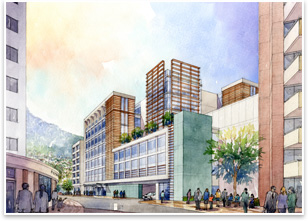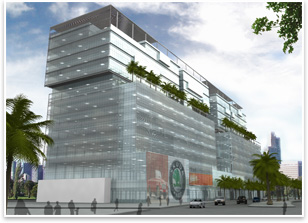Differing
Strategies Architecture Firms Are Using to Position Themselves Overseas
An essay on capturing emerging markets against a colonial backdrop
by Gideon Fink Shapiro
Summary: The
impact of the recession has led some firms to reorient their practices
toward institutional and government clients, some of which are capable
of forging ahead while private developers struggle to get back on
their feet. And in the redoubled search for new work, some architects
are reaching farther abroad, taking smaller projects in smaller markets,
such as South America and Africa.
When the domestic market is saturated, look abroad for new markets
and resources. That was a central piece of the logic that led European
powers to build overseas empires. In competing to expand their territory
in Africa and Asia, they developed at least two different strategies
of control. The French typically governed directly through their
own officers, while the British tapped into existing social hierarchies.
Both powers imported raw materials from their colonies to the home
country for manufacturing and sale on the world market.
As the global architecture market draws North American firms farther
afield, they are evolving different approaches to working effectively
in less developed regions. These firms are of course not out to dominate
territory or redirect local economies but to bring needed expertise
to the design of modern hospitals, schools, hotels, and infrastructure.
They benefit not by extracting natural resources and selling industrial
goods to a captive market, but by diversifying their client base
and positioning themselves to receive future commissions in emerging
markets.

Clinica Pasteur, Quito, Ecuador. Photo courtesy Perkins Eastman.
Empire was never cheap, and neither is expanding an architecture
practice to encompass remote regions. It takes financial muscle and
international prestige to win clients in developing countries, who
pay a premium not only for foreign architectural services but for
extra travel and communication costs. And the risks are higher when
you're an outsider. "Most of us who work internationally have
experienced how quickly conditions can change," wrote Bradford
Perkins, FAIA, principal chairman and CEO of Perkins Eastman, in
his 2007 book An Introduction to International
Practice. Even after
a heady decade-plus of capital investment and construction in countries
such as China, UAE, and India, most North American architects don't
venture south of the equator.
A new office becomes a standalone
Those that do are often members of the largest firms. For example,
Perkins Eastman announced the opening of a new office in Guayaquil,
Ecuador, in October 2008, just a week after the stock market's
precipitous fall. The firm has a history of involvement in South
America and acted on an opportunity to take over an existing Guayaquil
practice with local know-how and workflow. "We don't go into
a place sight unseen and just start doing business," says
Jonathan N. Stark, AIA, principal and managing director of the
firm’s overseas offices. In addition to building on the existing
client base in the region, Perkins Eastman planned to use the 10-person
office as an outsourcing station for the busy North American offices.
But as the recession hit, recounts Stark: "We became reluctant
to send work out of our offices in the States because we needed
it here." So Guayaquil became a self-sustaining branch of
the firm. Led by Stephen Forneris, AIA, it has continued to market
directly to clients in Latin America, receiving commissions for
institutional, hospitality, retail, and healthcare facilities.
Perkins+Will has taken another approach to operating in Africa and
Southeast Asia. Instead of investing in a permanent office, as they
did in London, Dubai, and Shanghai, they began collaborating with
a firm that was already equipped to work there, Dar Al-Handasah. "The
value that we bring is primarily in the upfront planning and design
development," says William Doerge, managing principal for the
firm's international practice. Doerge spoke to AIArchitect from outside
Luanda, Angola, where the firm is eight years into a major university
master-planning and design project. The Universidade Agostinho Neto
will unite the nine scattered schools of the national university
system into a new centralized campus eventually serving around 40,000
students. As Angola continues rebuilding from its 30-year civil war,
says Doerge, the university represents important "cultural infrastructure" that
will allow the country to educate its own professionals instead of
sending them abroad. Implementation of the phased master plan is
expected to continue over the next 15-20 years.
Forneris predicted to Architectural
Record last
November that
the effects of the recession would be less severe in Ecuador, since
credit was tight even in boom times. Similarly, the Brazilian architect
Luciano
Margotto said in March: "Here
the crisis is not too tough since the euphoria was never too great.” But
just because the contrast between pre- and post-recession conditions
is less marked in some regions, work opportunities are not necessarily
easier to come by. "The African markets are reacting to the
same thing that's affecting the developed markets," says Doerge.

Grupo Eljuri Building, Quito, Ecuador. Photo courtesy Perkins
Eastman.
A radically different model is embodied by Coloco, a small studio
based in Paris whose work was featured in the 2008 Venice Architecture
Biennale. Blending architectural installations, urbanistic experiments,
publications, and community planning, Coloco has completed projects
in Libya, Brazil, and Senegal as well as Europe. Coloco does not
wait to be invited to a new location by a client in the conventional
sense. Instead, the three partners launch projects as investigations
of problems that they observe and document. In Rio de Janeiro, for
example, they focused on the self-organizing communities that inhabit
the city's incomplete, abandoned high-rise "skeleton" buildings.
More recently, they have proposed a continuous "Greenbelt" of
public parks through the city of Tripoli, Libya.
Doerge says Perkins+Will is one of the only North American-based
architecture firms working in sub-Saharan Africa. He encounters British
firms building embassies in east African capitals, and notes the
steady stream of professional services flowing from South Africa.
The paradox of working in developing countries as a foreign expert
is that you may begin to facilitate your own redundancy. "As
markets mature, they start developing their own local architects
who will service that need at a lower cost," observes Doerge.
The old imperial powers addressed that problem by prohibiting their
colonies from refining the resources they supplied, such as rubber
or sugar. Today's global architectural services market is thankfully
much less constricted, as ideas and staff cross borders with spectacular
fluidity. Whether a given North American firm will profit by venturing
into less developed or "unspoiled" markets abroad depends
on developing local connections, a ready client base, and, in the
words of Doerge, "an ability to listen, understand people and
cultures."
|



